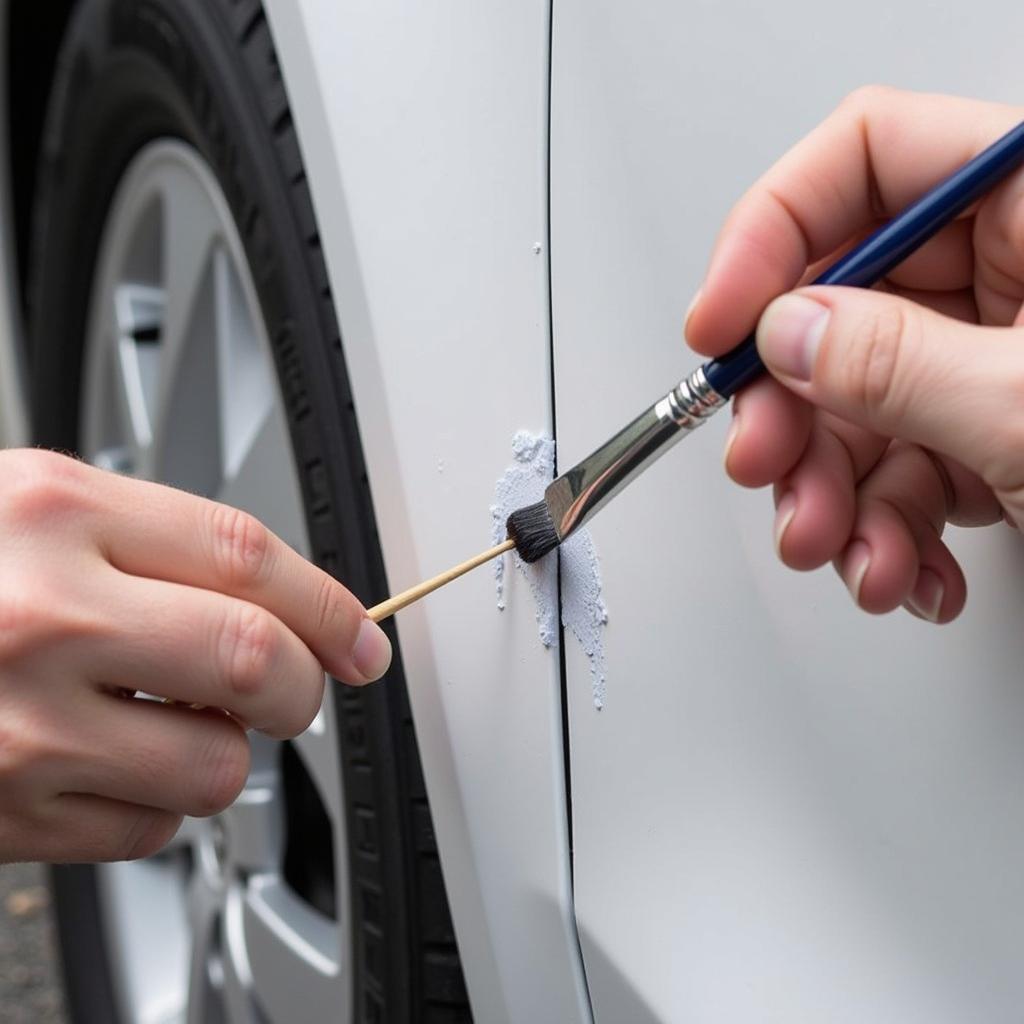Car paint chip repair tools are essential for anyone looking to maintain their vehicle’s appearance and protect it from further damage. From minor stone chips to larger scratches, these tools offer a cost-effective and convenient way to address paint imperfections without needing a professional body shop. This guide delves into everything you need to know about car paint chip repair tools, from choosing the right kit to mastering the application techniques. Learn how to achieve professional-looking results from the comfort of your own garage. After this first paragraph we’ll cover some tools and supplies needed for the repair process. For more in-depth information on supplies, check out our guide on car paint repair supplies.
Types of Car Paint Chip Repair Tools
Choosing the right car paint chip repair tool depends on the extent of the damage and your desired outcome. Several options cater to different needs and skill levels:
- Touch-up Paint Pens: Ideal for small chips and scratches, these pens offer precise application and are easy to use. They are available in a variety of colors to match your car’s paint.
- Paint Chip Repair Kits: These comprehensive kits typically include everything you need for a more thorough repair, including primer, paint, clear coat, applicators, and sanding tools. They are suitable for larger chips and scratches.
- Aerosol Spray Paint: For larger areas or a more uniform finish, aerosol spray paint can be an effective solution. However, it requires more skill and preparation to avoid overspray and achieve a seamless blend.
- Paintless Dent Repair (PDR) Kits: While not strictly for paint repair, PDR kits can be used to remove small dents that often accompany paint chips. This helps restore the smooth surface before applying touch-up paint.
How to Use a Car Paint Chip Repair Tool
Achieving a professional-looking repair requires careful preparation and application. Here’s a step-by-step guide:
- Clean the Area: Thoroughly clean the chipped area with soap and water, then degrease it with rubbing alcohol. This ensures proper adhesion of the repair materials.
- Sand if Necessary: If the chip has raised edges, lightly sand the area with fine-grit sandpaper to create a smooth surface. Be careful not to remove too much paint.
- Apply Primer (if using a kit): Apply a thin layer of primer to the chipped area and allow it to dry completely. This helps the paint adhere and provides a uniform base.
- Apply Touch-Up Paint: Carefully apply the touch-up paint to the chip, using thin coats to avoid runs and drips. Allow each coat to dry before applying the next.
- Apply Clear Coat (if using a kit): Once the paint is dry, apply a thin layer of clear coat to protect the repair and restore the shine.
- Sand and Polish (if necessary): For larger repairs, you may need to lightly sand and polish the area to blend the repair seamlessly with the surrounding paint.
For those looking for professional help with bubbling paint, check out our guide on repair bubbling paint on car.
Tips for a Flawless Finish
Here are some tips to help you achieve the best possible results:
- Match the Paint Color Precisely: Use your car’s paint code to ensure an exact color match.
- Work in a Well-Ventilated Area: This is especially important when using aerosol spray paint.
- Practice on a Scrap Panel: Before working on your car, practice on a scrap piece of metal to get a feel for the application process.
- Be Patient: Allow ample drying time between coats and avoid rushing the process.
Choosing the Right Car Paint Chip Repair Tool for Your Needs
What if your car needs more extensive repair work? Consider a paint repair shop car. They can handle larger damage or more complex repairs.
Different types of chips and scratches require different tools. How do you choose the right one? Consider the size and depth of the damage. For small chips, a touch-up pen might be sufficient. Larger chips or scratches may require a more comprehensive repair kit.
“Choosing the right tool is half the battle,” says automotive expert, John Miller. “A quality car paint chip repair tool, combined with proper technique, can make a significant difference in the final result.”
Why Car Paint Chip Repair is Important
Ignoring paint chips can lead to rust and further damage. Addressing them promptly helps maintain your car’s value and protect it from the elements.
“A small chip can turn into a big problem if left untreated,” warns Jane Smith, a seasoned car repair specialist. “Moisture can seep in, leading to rust and potentially requiring more extensive repairs down the road.”
If you are looking for mobile car paint repair services, you might be interested in exploring options like mobile car paint repair telford. Alternatively, you might want to consider car paint repair stickers for a quick fix.
Conclusion
Car paint chip repair tools offer a simple and effective way to address minor paint damage and maintain your car’s appearance. By choosing the right tool and following the proper application techniques, you can achieve professional-looking results and protect your investment from further damage. Don’t let small chips diminish your car’s beauty – take action and restore its pristine finish with the help of a car paint chip repair tool.
FAQ
- How long does it take for touch-up paint to dry?
- Can I use a car paint chip repair tool on any type of paint?
- How do I find the paint code for my car?
- What is the difference between touch-up paint and spray paint?
- How can I prevent future paint chips?
- Is it necessary to use a clear coat?
- Can I wash my car after using a car paint chip repair tool?
Need support? Contact us via WhatsApp: +1(641)206-8880, or Email: [email protected]. Our customer service team is available 24/7.



